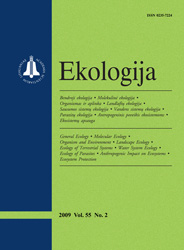
ISSN 0235-7224
ISSN 2029-0586 (online)
|
2010 m. Nr. 1-2
 Consumption and assessment of organic food by adult residents of Vilnius (Lithuania)
Rimantas STUKAS, Genė ŠURKIENĖ, Rūta DUBAKIENĖ, Reda NAGYTĖ, Marius BARANAUSKAS
The aim of the study was to investigate the extent of consumption and assessment of organic food by adult residents of Vilnius, Lithuania.
Methods. The target city of our research was Vilnius, the capital of Lithuania. It is the largest Lithuanian city hosting diverse nationalities with a variety of lifestyles and nutritional habits. The survey was conducted in largest supermarkets of Vilnius, by using anonymous questionnaires, from March to August 2008. The total amount of questionnaires circulated was 521, and 514 responses were received (response rate 98.7%). Residents of Vilnius were surveyed by using anonymous questionnairies. The questionnaire included enquiries about views on organic food, reasons for its consumption non-consumption, availability and access to the information.
Data analysis was performed with SPSS 14.0 software. The Mann–Whitney rank sum criterion (U) was used to evaluate statistically significant differences among the groups. A chi square (χ2) statistics was used to identify the association of qualitative features, and the number of the degrees of freedom was calculated (df). A p value less than 0.05 was considered to indicate a statistically significant difference (p < 0.05).
Results. Organic food was consumed by 82.1% of respondents (88.2% of women and 71.2% of men). In terms of frequency, Vilnius residents are rare consumers of organic food. Consumers with two or three times a week comprise 37.2% of the respondents, while the rest are even less frequent. The number of females who consume organic food is significantly greater than that of males (p < 0.05). However, men are found to be more frequent consumers. Also, organic food is consumed by a significantly greater amount of younger residents (p < 0.05). A significant association was observed among age groups and consumption (p = 0.009): subjects aged 18–34 were more frequent consumers. Those with university and vocational education showed a significantly higher consumption rate (p = 0.029), and 97.5% of the respondents would buy organic food products if they were less expensive. The prevailing reasons for choosing organic food were their (27.3%), healthiness (90.0%) and good taste (38.9%). The prevailing reasons for the absence of consumption: too expensive (53.3%), not tasty (5.4%), shorter expiry period (21.7%), inability to distinguish between organic and conventionally produced food (28.3%). Most frequently are purchased organic fruit, berries and vegetables (71.8%), dairy products, bread and other bakery products (49.3%), teas (42.9%), and meat products (29.9%). Compared to men, women buy significantly greater amounts of organic fruit, berries and vegetables (p = 0.010), eggs (p = 0.002), spices (p = 0.022), whereas men prefer bread and other bakery products (p = 0.002). In most cases consumers buy organic foods at supermarkets (83.6%), less frequently at farmers’ markets (34.1%), food fairs (11.8%), other places, e. g., specialised stores (14.9%). As 3.1% of our respondents have indicated that they do not purchase organic food but are organic food consumers, we assume that they grow organic food themselves.
Conclusions. Residents of Vilnius consume organic food because it is regarded to be healthy, and cite higher prices of organic food as the main prohibitive factor. Women and younger respondents are significantly more frequent consumers of organic food. The majority of residents when purchasing organic food at supermarkets are able to distinguish organic from conventionally produced food; however, they feel a lack of information on it.
According to our findings, higher prices of organic food remain the major prohibitive factor for its non-comsumption. Keywords: nutrition, organic food
|
Issues:
2011 - Vol.57 No. 1, No. 22010 - Vol.56 No. 1-2, No. 3-42009 - Vol.55 No. 1, No. 2, No. 3-42008 - Vol.54 No. 1, No. 2, No. 3, No. 42007 - Vol.53 No. 1, No. 2, No. 2.priedas, No. 3, No. 42006 No. 1, No. 2, No. 3, No. 42005 No. 1, No. 2, No. 3, No. 42004 No. 1, No. 2, No. 3, No. 42003 No. 1, No. 2, No. 3, No. 42002 No. 1, No. 2, No. 3, No. 42001 No. 1, No. 2, No. 3, No. 4 |
